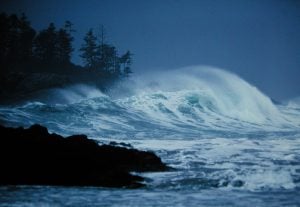
People & Culture
Safety first, service always: The Canadian Coast Guard turns 60
A celebration of the Canadian Coast Guard’s renowned search-and-rescue capabilities — and more — as the special operating agency turns 60
- 4392 words
- 18 minutes
This article is over 5 years old and may contain outdated information.
Travel
A three-day road trip along the Dorset coast offers fossils, fish and chips and Roman ruins

It was a beautifully shot British TV drama that first attracted me to the Dorset coast in southern England. Broadchurch was largely filmed in the lovely market town of Bridport, about a three-hour drive southwest of London, and the village of West Bay two kilometres south of that. Its stunning landmark, Harbour Cliff, is now widely known as Broadchurch Cliff.
I know, that’s a pretty shallow reason to visit a place. But once I got there, history drew me in — or should I say prehistory: coastal southern England is one of the only places in the world where the story of tens of millions of years of life on Earth is literally written in stone, visible to all on the dramatic cliff faces.
I arrived in Bridport in the late afternoon and checked in to The Bull Hotel, a gem of a place with an excellent restaurant and a rooftop bar boasting a huge gin-and-tonic cocktail list. Built in 1535, when Henry VIII was king, the hotel was originally a coaching inn, providing food, drink and rest to travellers and their horse teams. It’s said that during the 1815 Battle of Waterloo, at which a British-led coalition defeated Napoleon, the horses were changed here.
The bay window of my large, bright room overlooked the bustle of Bridport’s wide main street. The street had been made unusually wide so that ropes could be stretched from building to building across it to dry; since the 13th century, Bridport has been home to a thriving rope-making industry. Rope made here has been used for ships’ rigging, soccer and tennis nets (Wimbledon’s nets are made here), hangman’s ropes and even nets to catch German U-boats during the First World War. You need to know this if you’re to understand why there is a pub a few doors down from the hotel called The Ropemakers, where I can recommend a pint of the locally-brewed Palmers cask ale.

It’s an easy walk to West Bay to check out the famous Harbour Cliff and the spectacular coastline. The cliff is just one landmark along the Jurassic Coast, a UNESCO World Heritage Site that stretches for 153 kilometres through East Devon and Dorset counties. It’s thought to be the world’s finest record of the Triassic, Jurassic and Cretaceous periods. Collectively, those periods make up the Mesozoic Era, which began some 250 million years ago, when giant reptiles and dinosaurs walked the earth. (Another important Mesozoic site is Canada’s own Dinosaur Provincial Park near Calgary.)
At West Bay, I saw piled up on the shore some large rocks featuring what I later learned were chondrites, trace fossils that look like plant roots but are actually branched tunnel systems, possibly created by an ancient seafloor-dwelling organism. They also resemble—and some actually are—the footprints of prehistoric birds.
One fascinating figure to emerge from this region was Mary Anning, who was born in nearby Lyme Regis in 1799 and died in 1847. She was a fossil hunter who scoured these stretches of coastline and is widely credited with a major discovery at the age of only 12: after her younger brother found what appeared to be a fossilized crocodile skull, Mary unearthed a complete skeleton more than five metres in length. Scientists called the creature Ichthyosaurus, meaning “fish lizard” — though today we know ichthyosaurs were actually marine reptiles that lived during the Mesozoic era.
At the time, the theory of extinction had only recently been introduced, and Darwin’s On the Origin of Species wouldn’t be published for some 50 years. Anning made her living selling the fossils she found to museums and collectors but, being female at a time when women weren’t supposed to be scientists, she rarely got credit for her finds. Today, several of Anning’s fossils, including her ichythosaur, have pride of place in the Fossil Marine Reptiles gallery at the Natural History Museum in London. (If you’re interested in learning more about Anning, the 2009 historical fiction novel Remarkable Creatures by Tracy Chevalier brings her to life.)

From West Bay, I headed west along the green, sheep-studded walking path high above the beach, passing Thornecombe Beacon, one of a network of warning beacons first built in the 16th century to protect England’s shores from the dreaded Spanish Armada. I ended my day at The Anchor Inn pub at an inlet called Seatown, where I grabbed a picnic table by the shore and enjoyed the day’s special—fish and chips, naturally—as the waves crashed in.
The next day, I continued west in my rental car to historic Exeter, a small city on the River Exe. Living history is everywhere here, too, including at the Hotel du Vin near the city centre where I was given a lovely corner room in what was formerly the West of England Eye Infirmary. Built in 1899, it’s 100 per cent red-brick Victorian on the outside (and includes a pretty walled garden out back), but thoroughly boutique-modern inside, down to the large, whimsical breakfast room, which is brightened by multiple pendant lights and chic red-leather chairs.

Exeter is very pedestrian-friendly, with many contemporary cafés, shops and galleries to explore. But the truth is Exeter’s streets are ancient—and in fact, beneath them lies a large medieval aqueduct system you can visit today (tickets were unfortunately sold out the day I was there). The city’s wall, about 70 per cent of which still stands, dates to Roman times; it was built to protect the 5,000-man Second Augustan Legion established here in 55 AD. In fact, it seems this place was always on the defensive: the reason Exeter’s stunning gothic cathedral, founded in the 11th century, was sited here is that it was safely inside those Roman walls, and therefore protected from invaders (the Vikings were active at that time).
After a full day of soaking up the city—I even took in a football match between Exeter City F.C. and Swindon Town F.C. (Exeter won)—it was nice to spend my last evening before leaving England’s south coast dining at Rendezvous, a wine bar and restaurant just steps from my hotel. There is an al fresco dining area outside, but since this trip was all about history, and Rendezvous is in a heritage building, I chose to dine in the atmospheric lower-level wine bar.
Owner/manager Jemma Mitchell led me across the original flagstone floors through candlelit ambiance to a cozy table next to the exposed-brick wall. “Relax and enjoy your evening here,” she said, and left me with the menu—which is full of locally sourced items such as scallops from Lyme Regis and plaice from the Devon fishing town of Brixham. Meats and vegetables come from local suppliers, too. It struck me that this was just one more constant in a part of England in which so many other things remain unchanged after so many centuries.
Are you passionate about Canadian geography?
You can support Canadian Geographic in 3 ways:

People & Culture
A celebration of the Canadian Coast Guard’s renowned search-and-rescue capabilities — and more — as the special operating agency turns 60

Travel
An insider's guide to the parts of Britain you know — and some you don't

Environment
Initially targeted at visitors and locals in Tofino and Ucluelet, B.C., the CoastSmart program could save lives along all Canadian coasts

Science & Tech
The Adopt a Ship program took kids on a virtual behind-the-scenes tour with Coast Guard crews and staff